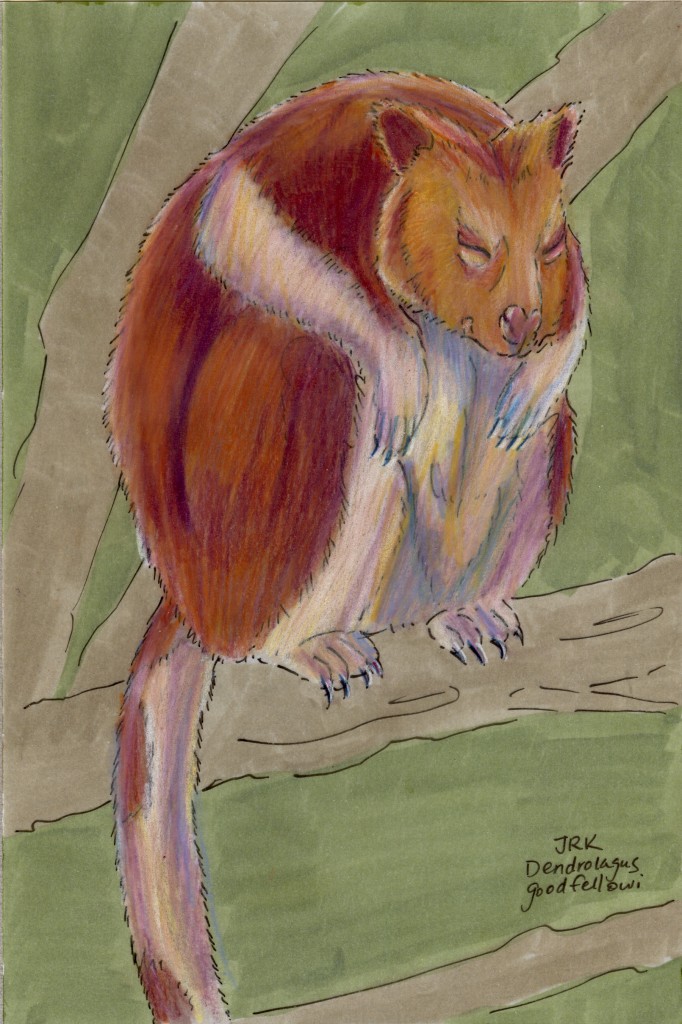Goodfellow’s Tree Kangaroo (Dendrolagus goodfellowi)
I’m eager to introduce you to an enchanting tree kangaroo, but first let me remind you that starting Sunday, Coco and I will be selling original drawings of the mammals of Japan with all proceeds helping victims of the earthquakes and tsunamis. See yesterday’s post for the details!
I have fallen in love with tree kangaroos. They are my new favorite animal. They’re magical; they sound like something someone made up for a children’s storybook. Like regular kangaroos, tree kangaroos are marsupials, and the two kinds of animals are related. It seems that all the kangaroos—tree and otherwise—evolved from a common ancestor. According to the 1947 book Furred Animals of Australia by Ellis Troughton (which, incidentally, has a most endearing dedication: “To my mother…to whom any originality of written thought is lovingly dedicated”),
“The tree-kangaroos are of particular interest in having undergone an unusual twist or secondary phase of evolution which is reflected in their appearance and habits. Originally descended like their fellows from primitive tree-dwelling stock, the adoption of a hopping means of progression resulted in marked lengthening of the hind-limb, with a corresponding loss of the possum-like clinging great toe, while the tail changed from a prehensile to a balancing implement. After the long period of terrestrial existence which moulded the kangaroo-like appearance, the animal reverted to the trees again for foraging and safety, with a corresponding reversal in general structure towards the arboreal type.”
In other words, in case you are not a natural at interpreting the words of early-20th-century naturalists like I am, Troughton’s saying that all the kangaroos descended from an early tree-dwelling mammal, then adapted to the plains through the evolution of big ol’ feet for hopping. They didn’t need to grasp trees with their back legs or prehensile tails, so they lost their handy big toes and their tails became big and sturdy—not agile for swinging through the branches but stable for balance. Then, the tree kangaroos re-evolved back into a treetop lifestyle among the branches of the cloud forest. That’s why they look, indeed, like kangaroos incongruously perched in the trees.
Troughton also says that this evolution—from treetops to the ground and back to the treetops—is an illustration of “the irreversible law of evolution wherein features lost owing to disuse cannot be regenerated.” The tree kangaroos’ ancient ancestors had prehensile tails; they evolved to have big balancing tails instead, and there’s no going back. If you’re a regular reader of this site, you know that I’m a fairly new student of evolution, and I believe this is the first time I read this “irreversible law,” or at least the first time it sunk in. What do you think of that idea?
There are 12 species of tree kangaroos, and they live in Australia and Papua New Guinea. This particular species, Goodfellow’s (and another question: why are some possessive scientific names spelled with two Is, like the other day’s finlaysonii and prevostii squirrels, but some only have one I, like today’s goodfellowi? I was expecting it to be goodfellowii) is endemic to Papua New Guinea and is endangered. Tree kangaroos have long been hunted for food by indigenous people, and their pelts are used in traditional ceremonies. Now they’ve been overhunted, and of course their habitats are also being destroyed because whose isn’t?
Another thing I like about tree kangaroos: if they jumped off a measly little boulder in an arroyo, they would not break their calcanea, the way I did two weeks ago. In fact, they routinely jump from the treetops to the ground 60 or more feet below without getting hurt! Isn’t that amazing? Here’s a remarkable video that includes footage of one of those jumps as well as “Crittercam” images from two tree kangaroos wearing cameras around their necks. (The beauties in the video are a different species, the Matschie’s tree kangaroo.)
I tell you, I adore them! I really do! And I’m not the only one. In fact, I found this lovely little story that says that before you judge someone else, think of the tree kangaroo, and remember that the other person loves the tree kangaroo just as much as you do. With that common foundation, can’t you find something else to agree on?


Beautiful drawing, and a TERRIFIC write-up! I feel like I know the tree kangaroo now, and I love them, too!
I don’t know about this “irreversible law of evolution” business. I mean, I understand that a creature that once had a prehensile tail won’t necessarily pop one back on when it needs to, but I don’t see why it couldn’t evolve one again over time if that’s a necessary adaptation or advantage for it! I don’t know, though… Thanks for giving me something to chew on!
Not buying the irreversible business. Natural mutations occur fairly regularly regardless of prior structure, and there’s probably a wide range of tail utility in the current population.
A more relevant question is whether a prehensile tail is advantageous to the point that it would be selected to promote survival. I don’t get the impression that these kangaroos are threatened by the lack of a prehensile tail, so there’s no reason to expect the population to favor mutations of that nature when they occur.
An old post I know, but on the subject at hand.
The ‘irreversible law’ was widely believed at the time, but is now considered to be false, as nearly all genetic mutations can be reversed, although some are more likely that others (single base substitutions easiest, something like an inversion hardest). An organism may go in a different direction entirely and is unlikely to re-evolve exactly the same feature, but it is possible to regain ‘lost’ traits.